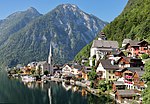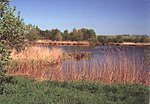 | The Hallstatt culture was the predominant Western and Central European archaeological culture of the Late Bronze Age (Hallstatt A, Hallstatt B) from the... 76 KB (8,519 words) - 22:53, 23 April 2024 |
 | Hallstatt (German: [ˈhalʃtat] ) is a small town in the district of Gmunden, in the Austrian state of Upper Austria. Situated between the southwestern... 22 KB (2,012 words) - 11:09, 26 April 2024 |
 | Slovakia (section Hallstatt Period) the production of textiles. The local power of the "Princes" of the Hallstatt period disappeared in Slovakia during the century before the middle of first... 154 KB (14,783 words) - 15:03, 27 April 2024 |
 | Urnfield culture (redirect from Urnfield period) Urnfield culture followed the Tumulus culture and was succeeded by the Hallstatt culture. Some linguists and archaeologists have associated this culture... 107 KB (11,288 words) - 14:06, 20 April 2024 |
 | Ancient history (redirect from Ancient period) Iron Age in Central Europe (Hallstatt period, named for the site in present-day Austria). By the later Iron Age (La Tène period), Celts had expanded over... 76 KB (9,428 words) - 15:03, 25 April 2024 |
 | Hallstatt culture. Four cultural layers were identified containing pottery ranging from the late Urnfield culture to the mid-Hallstatt culture period... 12 KB (1,513 words) - 21:58, 26 January 2024 |
 | Opfermoor Vogtei (section Hallstatt Period) which includes a shallow lake, was a supra-regional cult site from the Hallstatt Period (6th century BCE) to the Migration Age (5th century CE) developed by... 27 KB (3,327 words) - 14:17, 24 September 2023 |
 | Hallstätter See (redirect from Lake Hallstatt) Hallstätter See or Lake Hallstatt is a lake in Salzkammergut, Austria. It is named after Hallstatt, a small market town famous for its salt mining since... 2 KB (227 words) - 14:34, 30 July 2023 |
 | pile dwellings around the Alps. Remains of wooden bridges from the Hallstatt period (647 BC), the Roman era (AD 165) and the Early Middle Ages (AD 741)... 9 KB (863 words) - 07:06, 7 March 2024 |
 | La Tène culture (redirect from La Tène Period) Roman conquest in the 1st century BC), succeeding the early Iron Age Hallstatt culture without any definite cultural break, under considerable Mediterranean... 44 KB (4,347 words) - 15:45, 23 April 2024 |
 | of paleofeces sampled in the salt mines of Hallstatt (Austria) showed that miners of the Hallstatt Period (800 to 400 BC) already consumed blue cheese... 28 KB (3,217 words) - 19:39, 8 April 2024 |
Iron Age sword (category Swords by period) the world. The Celtic Hallstatt culture – 8th century BC – figured among the early users of iron. During the Hallstatt period, the same swords were made... 11 KB (1,456 words) - 00:51, 20 January 2024 |
 | 1100 to 900 BC; Period V (late), 900 to 700 BC. The Early Iron Age included Hallstatt Period C, 700 to 600 BC, and Hallstatt Period D, 600 to 450 BC... 41 KB (5,494 words) - 18:44, 18 January 2024 |
 | there is evidence for male wear in the early period; in a rich double burial of the Hallstatt period at Hochmichele, the man wears an iron torc and... 26 KB (3,436 words) - 22:23, 10 April 2024 |
 | V, c. 900–700 BC. The Early Iron Age included Hallstatt Period C, c. 700–600 BC, and Hallstatt Period D, c. 600–450 BC. Poland's Bronze- and Iron-Age... 14 KB (1,800 words) - 14:29, 3 August 2023 |
 | Salzkammergut (redirect from Hallstatt-Dachstein / Salzkammergut Cultural Landscape) in use at least since the days of the Celtic Hallstatt culture, centered at the mining town of Hallstatt. These operations were continued by the Romans... 15 KB (1,563 words) - 17:11, 6 April 2024 |
 | Hunsrück (section Roman period) settlement took place in the Early Iron Age (Hallstatt period) with the Laufeld culture and in the La Tène period (5th– 1st century B.C.) with the Hunsrück-Eifel... 31 KB (3,742 words) - 18:14, 15 February 2024 |
 | Celtic art (section Hallstatt gallery) the archaeologist, the rich "princely" burials characteristic of the Hallstatt period greatly reduce, at least partly because of a change from inhumation... 52 KB (6,845 words) - 18:29, 18 April 2024 |
 | Ancient Celtic women (category Women by period) Europe in the Late Bronze Age and early Iron Age (the Hallstatt culture). In the La Tène period they expanded, through migration and cultural transmission... 53 KB (7,608 words) - 21:17, 3 April 2024 |
 | The Hallstatt Museum (German: Museum Hallstatt) is a museum in Hallstatt, Upper Austria, that has an unrivalled collection of discoveries from the local... 11 KB (948 words) - 08:09, 25 December 2022 |










